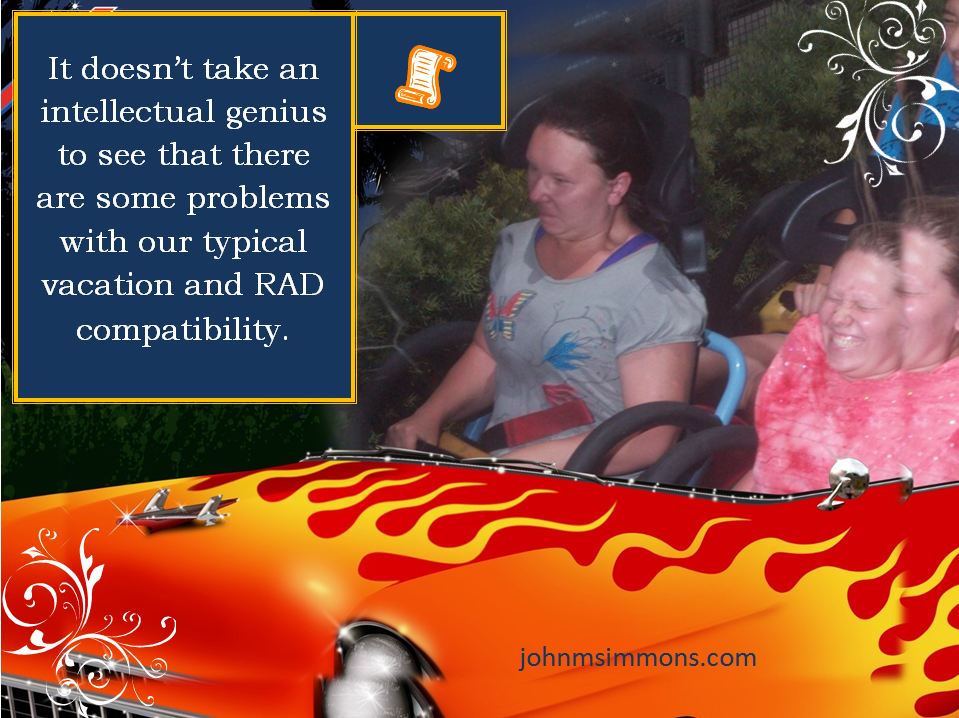Overstimulation and Reactive Attachment Disorder: Vacations
Overstimulation and Reactive Attachment Disorder make vacation the Devil! My daughters who have Reactive Attachment Disorder have stared death in the face. I won’t bother to detail all of the types of abuse that they were exposed to in their firs homes, shacks, situated in poverty-stricken Russian villages. Even so, adrenaline rushes would have been extreme and frequent.
In fact, watching children in my family who have Reactive Attachment Disorder causes me to wonder if some of them have adrenaline addiction. Some people doubt that such an addiction exists, but a self-proclaimed former adrenaline addict posted a very interesting blog on Mental Health Daily. It seems to describe what I see in one of my daughters. Sometimes my daughter causes high stress situations for no apparent reason. A craving for adrenaline provides an explanation for what we see in many situations. For Emily, overstimulation and RAD are just a way of life. Don’t talk about “disorder” or “over” anything. That is normalcy!
The argument of whether or not adrenaline addiction exists is neither here nor there. It doesn’t change one of the problems for people with Reactive Attachment Disorder that I have agitated with typical Simmons family vacations and activities. Our vacations have been built around hair flying back in the wind. Fast cars, motorcycles, quads, snowmobiles, and rollercoasters are favorites. That’s before we even get in the water behind boats for a myriad of other adrenaline producing activities. When the Simmons family comes home from a vacation, most of us are glad to get back to work for some well-needed rest.
As our children clamor for more exciting activities, we have always written it off to greediness. Now I’m not so convinced.
It doesn’t take an intellectual genius to see that there are some problems with our typical vacation and RAD compatibility. Overstimulation and Reactive Attachment Disorder are gasoline and matches. In the Simmons family, we spend several days of vacation boosting our adrenaline production to the limits. In so doing, we have caused difficulties for family members who suffer from Reactive Attachment Disorder. There was a time in my daughters’ lives when they were in constant danger. Adrenaline was continually used in self preservation. At that time, performance enhancement, pain reduction, fast reaction and immediate physical reaction are what kept them safe. Whether or not there are adrenaline addictions, people in my family who suffer from RAD get an over-supply of adrenaline on our vacations. That’s not the worst part of our mixing overstimulation and Reactive Attachment Disorder during those times.
We bring these children home to somewhat boring, every-day lives. Then the adrenaline is turned off as if by a spigot. As our children clamor for more exciting activities, we have always written it off to greediness. Now I’m not so convinced. It seems more plausible that maximizing adrenaline production for several days of vacation is causing a demand for more. By spending an extended period mixing overstimulation and Reactive Attachment Disorder, we have opened a well that can’t be filled.
Overstimulation and Reactive Attachment Disorder will continue to coexist in the Simmons family. But I do think that our current family makeup would be better served by toning vacations down a bit.
I don’t think most of us can relate to the level of excitement that people with RAD live when they are in the conditions that foster the development of that disorder. Since their early lives were so unpredictable, they have come to understand that life is a series of completely random and uncontrollable events. When we go on vacation and shortly thereafter, I see a return to many undesirable behaviors that I saw from my children when they first came home to our family. Could it be that the fault is mine rather than that of their condition? Isn’t it plausible that my act of putting my children in environments where they experience overstimulation is part of the problem? In spending an extended time feeling the feelings that they felt during the worst part of their lives, isn’t it likely that behaviors of the same time might also surface?
I’m not saying that the Simmons family is going to take up flower-picking and turtle riding as vacation activities. Overstimulation and Reactive Attachment Disorder will continue to coexist in the Simmons family. But I do think that our current family makeup would be better served by toning vacations down a bit. I also think that the staff at the group home where my oldest daughter lives stumbled onto another important concept.
My daughter struggled after our last vacation but it was less in intensity and duration. While I believe that part of that reduction was based on the normal but snail-like progress we see in our children with RAD, there is more to it. Upon her return, the staff at Emily’s group home kept her busy at the gym, playing, and observing sports. They even spent a half a day at a local amusement park. For the first time ever, Emily was given a wind-down period rather than an immediate end to an adrenaline filled vacation. It appears that when overstimulation and Reactive Attachment Disorder get together, we should separate them gradually rather than abruptly when we return back home.
Read part I: Preface
Read Part II: Hypervigilance
Read Part IV: Inconsistency
Your comments matter. Please scroll down and share your thoughts!
Read more blog articles by John M. Simmons about Disorders/Mental Illness
Return to John M. Simmons’ blog
Ensure you don’t miss anything by signing up for Our Weekly Newsletter. This is all you need to be qualified for occasional giveaways like the Kindle Fire that Kristy Goulart won in July!

